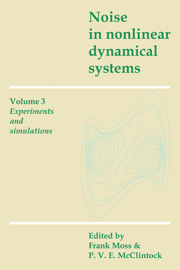Book contents
- Frontmatter
- Contents
- List of contributors
- Preface
- Introduction to Volume 3
- 1 The effects of colored quadratic noise on a turbulent transition in liquid He II
- 2 Electrohydrodynamic instability of nematic liquid crystals: growth process and influence of noise
- 3 Suppression of electrohydrodynamic instabilities by external noise
- 4 Colored noise in dye laser fluctuations
- 5 Noisy dynamics in optically bistable systems
- 6 Use of an electronic model as a guideline in experiments on transient optical bistability
- 7 Computer experiments in non-linear stochastic physics
- 8 Analogue simulations of stochastic processes by means of minimum component electronic devices
- 9 Analogue techniques for the study of problems in stochastic nonlinear dynamics
- Index
3 - Suppression of electrohydrodynamic instabilities by external noise
Published online by Cambridge University Press: 05 January 2012
- Frontmatter
- Contents
- List of contributors
- Preface
- Introduction to Volume 3
- 1 The effects of colored quadratic noise on a turbulent transition in liquid He II
- 2 Electrohydrodynamic instability of nematic liquid crystals: growth process and influence of noise
- 3 Suppression of electrohydrodynamic instabilities by external noise
- 4 Colored noise in dye laser fluctuations
- 5 Noisy dynamics in optically bistable systems
- 6 Use of an electronic model as a guideline in experiments on transient optical bistability
- 7 Computer experiments in non-linear stochastic physics
- 8 Analogue simulations of stochastic processes by means of minimum component electronic devices
- 9 Analogue techniques for the study of problems in stochastic nonlinear dynamics
- Index
Summary
Introduction
Over the last few years the investigation of the transition to turbulence (Ahlers and Behringer, 1978; Croquette and Pocheau, 1984; Gollub and Benson, 1980; King and Swinney, 1983; Swinney and Gollub, 1981) has mainly focused on two systems: on the Rayleigh–Benard convection, which arises when a thin layer of a simple fluid is heated from below; and on the Taylor instability, for which the simple fluid in the gap between two concentric cylinders is subjected to an external torque by rotating the inner or both cylinders. In both configurations a transition from a quiescent state to spatial turbulence via some intermediate, spatially periodic patterns is observed.
A marked influence of the aspect ratio for both instabilities, as well as of the shape of the container for Rayleigh–Benard convection, is well documented (Ahlers and Behringer, 1978; Croquette and Pocheau, 1984).
No systematic study on the influence of controlled external noise on the transition to turbulence had been done prior to the experiments to be described below and very few qualitative results were known.
The big open question was: Can external noise influence or alter the transition to turbulence qualitatively in pattern-forming nonequilibrium systems, or is it a mere perturbation leaving the main features unchanged?
This was the main motivation triggering our studies on the electrohydrodynamic instability (abbreviated as EHD throughout the rest of this chapter) in nematic liquid crystals.
- Type
- Chapter
- Information
- Noise in Nonlinear Dynamical Systems , pp. 77 - 89Publisher: Cambridge University PressPrint publication year: 1989
- 2
- Cited by



